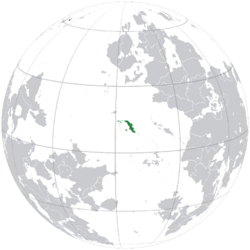Renovationalist Montilla: Difference between revisions
No edit summary |
No edit summary |
||
| (One intermediate revision by the same user not shown) | |||
| Line 129: | Line 129: | ||
'''Renovationalist Montilla''', also referred to as the '''Heinous Republic''' ({{wpl|Spanish language|Spanish}}: ''República Atroz'' {{wpl|International Phonetic Alphabet|[reˈpuβlika aˈt̪ɾos]}}), officially the '''State of Montilla''', refers to the period of [[History of Montilla|Montillan history]] from 1945 to 1958. It started after the [[Guaitiazo|coup d'etat]] by [[Leonardo Murillo]]'s [[National Renewal Alliance]] and portions of the Montillan Armed Forces in 1945, which established a regime known for {{wpl|human rights violations}}, {{wpl|censorship|extensive censorship}}, institutionalized {{wpl|torture}}, {{wpl|extrajudicial killings}}, {{wpl|forced disappearances}}, {{wpl|political persecution}} and the {{wpl|genocide|systematic killing}} of native populations, homosexuals, socialists, communists, liberals and anti-fascists. | '''Renovationalist Montilla''', also referred to as the '''Heinous Republic''' ({{wpl|Spanish language|Spanish}}: ''República Atroz'' {{wpl|International Phonetic Alphabet|[reˈpuβlika aˈt̪ɾos]}}), officially the '''State of Montilla''', refers to the period of [[History of Montilla|Montillan history]] from 1945 to 1958. It started after the [[Guaitiazo|coup d'etat]] by [[Leonardo Murillo]]'s [[National Renewal Alliance]] and portions of the Montillan Armed Forces in 1945, which established a regime known for {{wpl|human rights violations}}, {{wpl|censorship|extensive censorship}}, institutionalized {{wpl|torture}}, {{wpl|extrajudicial killings}}, {{wpl|forced disappearances}}, {{wpl|political persecution}} and the {{wpl|genocide|systematic killing}} of native populations, homosexuals, socialists, communists, liberals and anti-fascists. | ||
The regime enjoyed wide support from the more nationalist elements in the Montillan middle and upper classes through its duration, with outright cooperation and aquiscience from national companies and oligarchical families in the policies of extermination and forced labor. There was widespread resistance through the duration of the regime from various {{wpl|guerilla}} groups, most prominently the [[Montillese Revolutionary Movement|Montillan Revolutionary Movement]], which would lead the [[Montillan Revolution]] and overthrow the regime. | |||
==Background== | |||
{{main|Third Republic of Montilla}} | |||
{{Country icon Montilla}} | |||
{{Template:Anteria info pages}} | |||
[[Category:Anteria]] | |||
[[Category:Montilla]] | |||
Latest revision as of 02:43, 24 March 2024
This article is incomplete because it is pending further input from participants, or it is a work-in-progress by one author. Please comment on this article's talk page to share your input, comments and questions. Note: To contribute to this article, you may need to seek help from the author(s) of this page. |
State of Montilla Estado de la Montilla | |||||||||
|---|---|---|---|---|---|---|---|---|---|
| 1945–1958 | |||||||||
| Motto: "Soberanía y Orgullo" (Anterian Common: "Sovereignty and Pride") | |||||||||
| Anthem: "Himno de la Independencia" (Anterian Common: "Anthem of Independence") | |||||||||
 | |||||||||
| Capital | Guaitiao | ||||||||
| Common languages | Spanish | ||||||||
| Demonym(s) | Montillan | ||||||||
| Government | Unitary one party fascist presidential republic under a totalitarian dictatorship | ||||||||
| Caudillo | |||||||||
• 1945-1958 | Leonardo Murillo | ||||||||
| Legislature | National Assembly | ||||||||
| History | |||||||||
| 26 April 1945 | |||||||||
| 11 December 1958 | |||||||||
| Currency | Peso | ||||||||
| |||||||||
Renovationalist Montilla, also referred to as the Heinous Republic (Spanish: República Atroz [reˈpuβlika aˈt̪ɾos]), officially the State of Montilla, refers to the period of Montillan history from 1945 to 1958. It started after the coup d'etat by Leonardo Murillo's National Renewal Alliance and portions of the Montillan Armed Forces in 1945, which established a regime known for human rights violations, extensive censorship, institutionalized torture, extrajudicial killings, forced disappearances, political persecution and the systematic killing of native populations, homosexuals, socialists, communists, liberals and anti-fascists.
The regime enjoyed wide support from the more nationalist elements in the Montillan middle and upper classes through its duration, with outright cooperation and aquiscience from national companies and oligarchical families in the policies of extermination and forced labor. There was widespread resistance through the duration of the regime from various guerilla groups, most prominently the Montillan Revolutionary Movement, which would lead the Montillan Revolution and overthrow the regime.
Background

